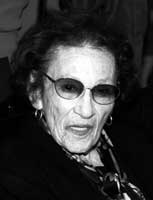
Maxine Greene, Philosopher & Aesthete
by Joan Baum, Ph.D.
What’s immediately apparent about Maxine Greene, Barnard class of `38, the philosopher queen of aesthetic education, who has, in fact, been referred to as “the most important American philosopher [on education] since John Dewey” and “the consummate spider woman,” for her groundbreaking interdisciplinary research, is her memory. Moving about slowly now—sciatica, but “what the hell”—she continues to exhibit the same kind of spirited intelligence, spiked with humor, that has marked her long professional life. Names from the near and distant past come easily to her—she must know and have known just about everyone who was anyone in the world of art, philosophy, literature, education, administration, and social activism of all sorts. She talks without missing a beat, theme or subtle ramification. For all the initiatives—the first woman, the first Jew, the first editor, teacher, professor—she tends toward amusing, self-deprecating comments—such is her confidence, her achievement. And her continuing energetic dedication. On the day Education Update caught up with her in her apartment, she off-handedly acknowledged flowers just sent to her by Lincoln Center Institute colleagues for one week’s work: several workshops on literature as art and eight lectures on aesthetic philosophy.
In a field which still seems to many jargon ridden, Maxine Greene comes across as a straight shooter. A great reader and shrewd critic, a lover particularly of literature, history and philosophy (the existentialists were always favorites), she says that she “never wanted to be in education, but there I was” (women were not welcome where she wanted to be). And so she went on for a doctorate in education at NYU, concentrating on the humanities—she still recalls a course on post-Elizabethan drama. She hoped to teach philosophy. What emerged, from her many interests, turned out to be a subject she wound up teaching herself—aesthetics in, and the aesthetics of, education. And then it was Maxine Greene, off making history, including helping found the Lincoln Center Institute for bringing artists into the schools and schools to the arts.
She wishes she could be more sanguine today about the ideas she’s championed all her life. Too many people talk about the importance of the arts in and to the schools but don’t deliver, she says. The professional radical in her is roused. She would like people to write letters to political candidates and insist that in all plans for curricular reform, which center on assessment and accountability, attention be paid to music, visual arts, dance—she is particularly concerned about children using their bodies well. She is also quick to distinguish between pedestrian and imaginative. As Dewey emphasized, the creative life must be nurtured, the arts must be naturally, integrally brought into the schools.” The names of particular teachers come to mind—this one brought a string quartet to her school, that one a dancer. You don’t just show a Rembrandt, you make art part of learning a discipline and you recognize the difference between providing information and stimulating a love of knowledge.
She surprises by her vision of what might be called democratic elitism. “I hate the idea of distance learning,” she says, and then quickly adds that there can be great value in computers and video learning—children who can’t get to museums have wonders online. But the key is stimulating the imagination, and for that, teachers need to study epistemology. And appreciate how in a city like New York, with its diverse cultures, that culture itself, defined by art, can be a terrific educational stimulus. Incidentally, she points out, in Indonesia, there is no word for art—no need, “it’s all around.” Is she optimistic about recent changes in the education community in the city? She smiles. There are some wonderful teachers around, and she does appreciate political necessities and budget shortfalls, but she worries about declining opportunities for creative teaching. “Art is a pathway to dreams” and, she might readily have added, recalling the influential mid-century American poet Delmore Schwartz, “in dreams begin responsibilities.”#
